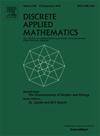Grundy packing coloring of graphs
IF 1
3区 数学
Q3 MATHEMATICS, APPLIED
引用次数: 0
Abstract
A map of a graph is a packing -coloring if every two different vertices of the same color are at distance more than . The packing chromatic number of is the smallest integer such that there exists a packing -coloring. In this paper we introduce the notion of Grundy packing chromatic number, analogous to the Grundy chromatic number of a graph. We first present a polynomial-time algorithm that is based on a greedy approach and gives a packing coloring of any graph . We then define the Grundy packing chromatic number of a graph as the maximum value that this algorithm yields in . We present several properties of , provide results on the complexity of the problem as well as bounds and some exact results for .
图形的Grundy填充着色
图G的映射c:V(G)→{1,…,k}如果相同颜色i∈{1,…,k}的每两个不同顶点的距离大于i,则该映射c:V(G)→{1,…,k}是一个填充k着色。G的填充色数χρ(G)是使得存在一个填充k着色的最小整数k。本文引入了格朗第填充色数的概念,类似于图的格朗第色数。我们首先提出了一个基于贪心方法的多项式时间算法,并给出了任意图G的填充着色。然后定义了图G的Grundy填充着色数Γρ(G)作为该算法在G中产生的最大值。我们给出了Γρ(G)的几个性质,提供了问题复杂性的结果以及Γρ(G)的界和一些精确结果。
本文章由计算机程序翻译,如有差异,请以英文原文为准。
求助全文
约1分钟内获得全文
求助全文
来源期刊

Discrete Applied Mathematics
数学-应用数学
CiteScore
2.30
自引率
9.10%
发文量
422
审稿时长
4.5 months
期刊介绍:
The aim of Discrete Applied Mathematics is to bring together research papers in different areas of algorithmic and applicable discrete mathematics as well as applications of combinatorial mathematics to informatics and various areas of science and technology. Contributions presented to the journal can be research papers, short notes, surveys, and possibly research problems. The "Communications" section will be devoted to the fastest possible publication of recent research results that are checked and recommended for publication by a member of the Editorial Board. The journal will also publish a limited number of book announcements as well as proceedings of conferences. These proceedings will be fully refereed and adhere to the normal standards of the journal.
Potential authors are advised to view the journal and the open calls-for-papers of special issues before submitting their manuscripts. Only high-quality, original work that is within the scope of the journal or the targeted special issue will be considered.
 求助内容:
求助内容: 应助结果提醒方式:
应助结果提醒方式:


